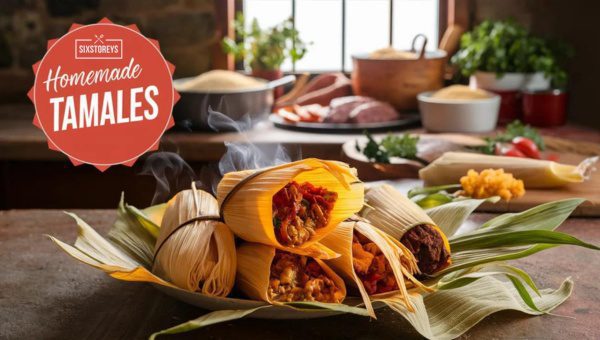How to Master Tamales at Home? Step by Step Guide
There's something truly special about homemade tamales. The rich flavors, the enticing aroma, and the sheer joy of biting into a perfectly wrapped offering of masa and filling, all make the work that goes into creating these delightful parcels absolutely worthwhile. But if you’ve never made tamales at home, the process might seem daunting or time-consuming.
Allow me to demystify it for you. From the essentials of gathering your ingredients to the final stages of cooking, we're going to explore the journey of making homemade tamales together - one that will not only tantalize your taste buds but also awaken your inherent culinary creativity. Whether you're a seasoned kitchen adventurer or a curious beginner, join me as I unravel the magic behind transforming simple ingredients into something extraordinary: homemade tamales.
Also Read: Best Masa Harina Substitutes

Article Includes
Unwrapping the Secrets of Homemade Tamales
Before diving headfirst into the world of tamale-making, it's crucial to have a basic understanding of what makes a truly satisfying tamale. At its core, a tamale is a traditional Mesoamerican dish made of masa (a dough made from nixtamalized corn) filled with meats, cheeses, fruits, or any other fillings you fancy, wrapped in a corn husk, and then steamed or boiled.
Indigenous peoples in Central and South America have been making tamales for thousands of years. This culinary tradition passed through generations has a deep cultural and historical significance. The joy of tamales rests not only in the delightful flavors but also in the sense of communion it fosters in families and communities.
Tamale Ingredients: A Peek Inside My Kitchen
But what does it actually take to make tamales at home? Let me walk you through the key ingredients you'll need.
First on the list, of course, is the masa. The type of masa you use determines the texture and taste of your tamales. I personally prefer masa harina, a pre-cooked corn flour that is easy to use and widely available.
The filling is where you can let your culinary creativity shine! The most commonly used fillings include slow-cooked pork, chicken, or beef. However, vegetables, beans, cheese, or even sweet fillings like fruits, chocolate, or nuts can also be used for a delightful twist.
Finally, you'll need corn husks. These are soaked in water and serve as the wrapping for the masa and filling before it’s cooked. Not only do they hold everything together during the cooking process, but they also impart a subtle, earthy flavor to the tamales.
Preparing Your Tamale Spread: It's More Than Just a Masa
As we start preparing the tamale spread, it becomes clear that it's so much more than just masa. The dough is combined with lard or vegetable shortening, broth, baking powder, and seasonings until it reaches a fluffy consistency. This is then spread onto the corn husks where it creates a cozy pocket for your chosen fillings.
For the meat-based fillings, slow-cooked meats in rich, well-seasoned sauces work best. But let's not forget our vegetarian and vegan friends! Delicious tamale fillings are by no means limited to meat. Go for sautéed vegetables, cheese, or vegetarian stews, which are equally delectable and satisfying.
Preparing the spread is truly a team effort – and that's part of what makes homemade tamales so special. As the masa is spread and the fillings are prepared, the kitchen becomes filled with the chatter of shared stories, the warmth of laughter, and the anticipation of a delicious meal. This sense of community is, after all, the true secret ingredient of every homemade tamale.
Mastering The Art of Tamale Assembly

Whether you're a novice or have been making tamales for years, mastering the art of assembly can always be a hair-raising task. Fear not, for with some practice and patience, this too can become second nature.
First, let's gather our tools. You'll need corn husks, masa, your filling, and a spoon or spatula. Begin by soaking the corn husks in warm water until they are soft and pliable. This step is important as it prevents the husk from breaking when we start to roll.
Next, spread a scoop of masa onto the corn husk, leaving some room at the edges. Now comes the fun part - adding the filling. It could be your preferred meat, veggies, or even fruits if you're feeling adventurous! Be generous, but don't overload it, to avoid any spillovers.
Once your filling is in place, fold the corn husk over and roll it neatly to encase the filling. The final step is to fold the narrow end of the corn husk up, and voila! You have just mastered the art of tamale assembly.
Cooking Tamales: Patience is a Virtue
Now that we've assembled our tamales, it's time to cook! Your homemade tamales are going to need careful and slow steaming, so patience definitely is a virtue here. While there may be a temptation to rush through, trust me, the magic happens slowly in this process.
Start by standing your assembled tamales upright in a steamer basket and cover them with a damp cloth or extra husks. This helps to trap the heat and cook the tamales thoroughly. Keep the water simmering on low heat and allow them to steam for about 90 minutes to two hours.
You can check for doneness by carefully removing one tamale and letting it cool. The tamales are done when the masa pulls away from the husk easily; if it sticks, they need more steaming time. Remember, the mantra for delicious, melt-in-your-mouth tamales is: slow and steady.
Variable Tamales: Unleashing Your Creativity
One of the most exciting parts about homemade tamales is how infinitely adaptable they are. Tamales offer a blank canvas for you to unleash your kitchen creativity. While traditional recipes certainly have their charm and value, don't be afraid to mix things up and experiment with different fillings to create your own unique tamale concoctions.
Ever thought about a sweet tamale? Try a bit of banana-infused masa with a filling of chocolate or sweetened cream cheese for an unexpected dessert! Maybe you're a fan of bold, spicy flavors? Then go for a filling with jalapeños, tangy tomatoes, or chipotle peppers.
Remember, the magic of homemade tamales lies not just in their irresistible taste, but in the joy of exploration and the experience of making something truly your own. So go on, let your culinary creativity run wild and enjoy the journey of homemade tamale making.
The Joy of Sharing Homemade Tamales
A significant part of the allure of making homemade tamales is the joy of sharing them with others. Whether you're introducing friends to this delightful dish for the first time or rekindling memories of cherished family traditions, there's a unique satisfaction that comes from seeing the positive reactions as each tamale is unwrapped and savored.
Not only are tamales delicious, but they're also quite versatile! From birthday parties to Sunday brunch, and potluck dinners, these gems fit right in. In fact, the tradition of making tamales often turns into a social gathering known as a 'tamalada', where friends and family participate in the preparation. As the saying goes, "many hands make light work," and in this context, it imbues a sense of communal spirit and shared accomplishment.
What's more, tamales make excellent gifts. Wrapping a batch in a charming basket or a colorful dish towel elevates them from a humble meal to an artisanal gift, where each bite tells a story of the care that went into making them.
Storing and Reheating Tamales: Keeping the Flavor Alive
If, by some miracle, you find yourself with leftover tamales, you'll be pleased to know that they store remarkably well. Tuck them into a zip-lock bag or an airtight container and pop them into the fridge where they can last up to a week. For longer storage, tamales freeze perfectly for up to six months.
When it's time to reheat, the key is to do it gently to retain the moisture and keep the flavor alive. You can use a steamer, a warm oven, or even a skillet with a bit of water on low heat. Microwaving is also an option, but be sure to cover them in a damp paper towel to prevent drying out.
Also Read: Best Store-Bought Enchilada Sauces
Conclusion
Homemade tamales are not just a dish; they are an experience. From the process of making them to sharing and enjoying them with others, every bit is filled with joy and satisfaction. Not to mention, the flavors of homemade tamales tend to outshine any store-bought version — a true testament to the magic that happens when we put our hands and heart into making food from scratch.
Even if the process appears lengthy at first, don't let that discourage you. After all, good things come to those who wait, and in the case of tamales, the reward is a deliciously rich and authentic taste that you (and those lucky enough to share them with you) won't soon forget.
So go forth, venture into the wonderful world of tamale-making, and allow yourself to be captivated by its charms. May your culinary journey be filled with experiences as delightful and satisfying as the tamales you are about to create.
